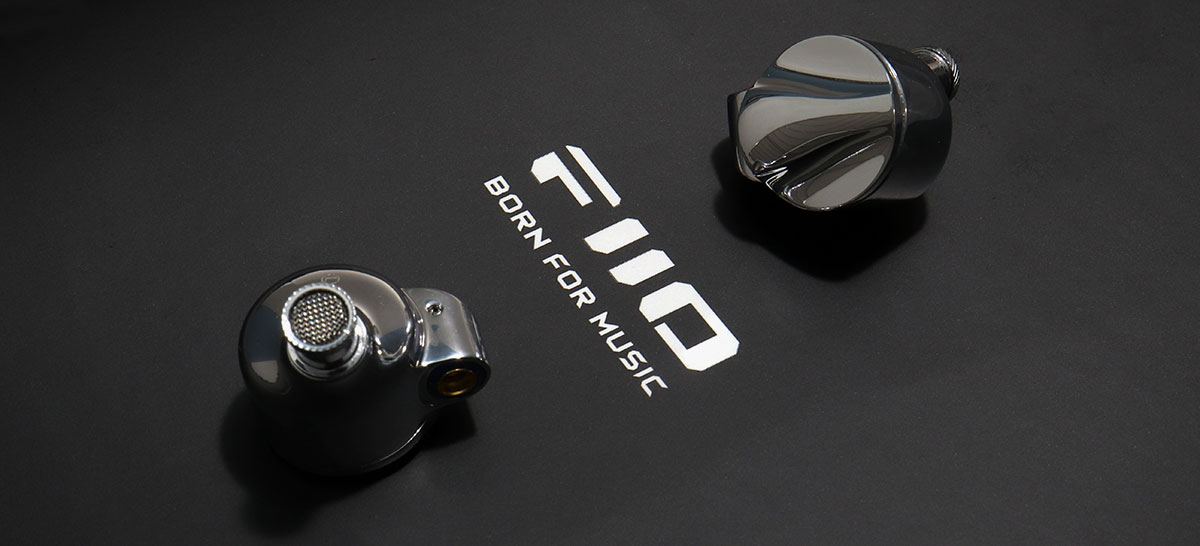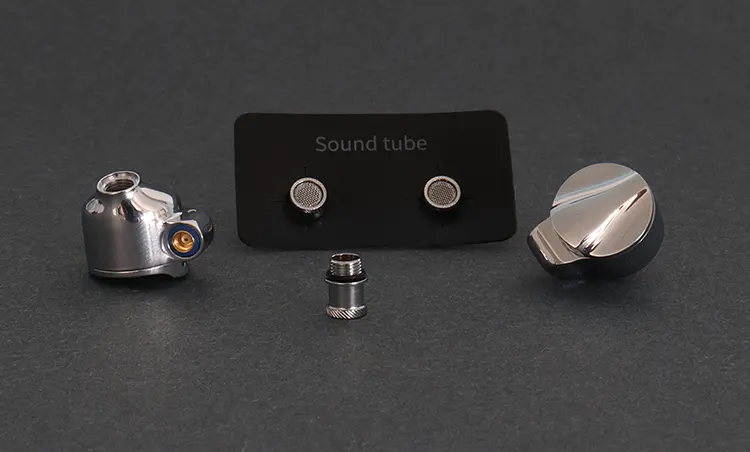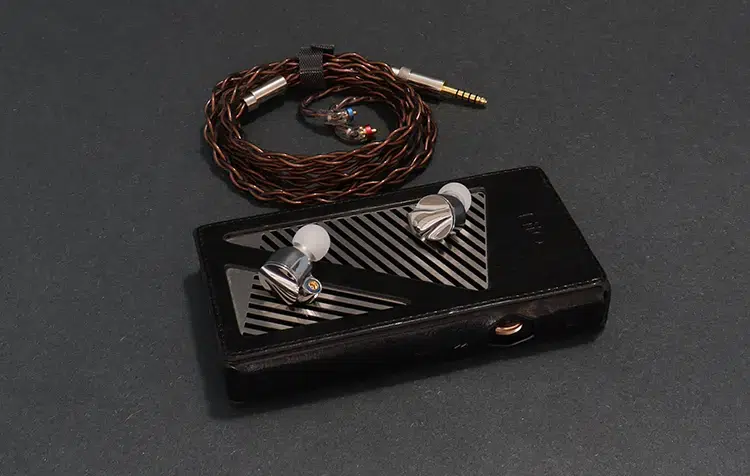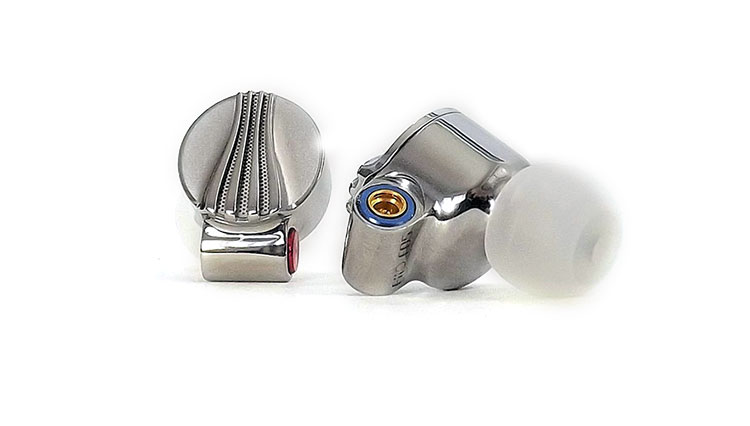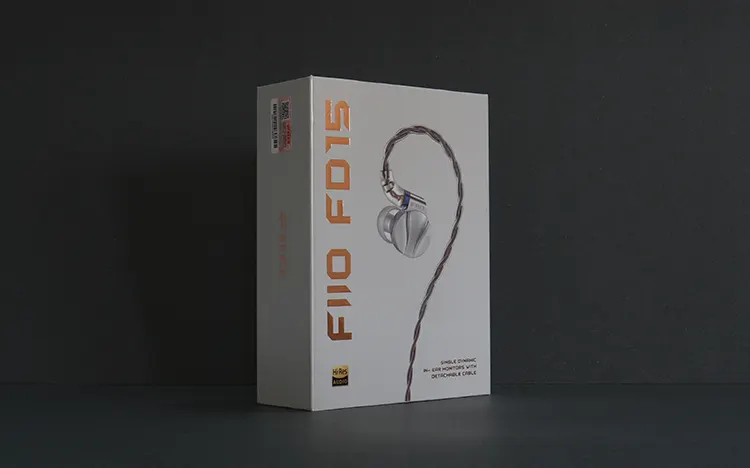Synergy
Efficiency
The FiiO FD15 is very sensitive but overly so since it seems to handle high-power gear very well. I ran them with my powerful desktop setup, the 11.5 watts per channel SH-X, and experienced no issues.
What I did notice was no sonic ‘upscalability’. The FD15 has a small audible sensitivity to differences in amplification but not by much. It seems to be affected more so by DAC and source quality.
Swappable Audio Filters
I tried both nozzle filters on the FiiO FD15 and found no difference in bass response between the two nozzle sets. What I did find was an increase in soundstage height on the red nozzles which I thought was lacking on the Black nozzles.
If you look at FiiO’s graphs you’ll notice that the bass response remains the same on both sets. Most of the changes take place within the high frequencies and there’s a small increase in high frequency production on the black filters but the red filters seem to produce an increase in midrange unseen on the graphs.
For vocals, my favorite tips are the Black filters because for some reason my ears preferred the smoother midrange characteristics of the Black filters.
Which one is my preferred set overall? The Black set implements better control overall. The black tips are better balanced in my opinion but you do hear more detail with the Red set which I feel is lacking in the Black set.
Pairings
This is where things get interesting because of the tuning options. Pair the FD15 with FiiO gear and you might be like me and prefer the Black filters over the Red variants because of the overall forgiveness in tuning.
But use gear that’s a bit tamed like the Shanling H2 recently reviewed if you want a smoother sonic experience but things change and the Red tips are preferred in this pairing because they counterbalance the overly smooth characteristics of the H2.
My FiiO M11 Pro preferred the Black filters because even though the Black filters have an increase in high-frequency production, the Red filters mid-frequency increase was too vivid for the already vivid characteristics of the M11 Pro’s THX amplification.
Select Comparisons
FiiO FD5
Technical
Although the FD5 is the big brother to the FD15, it uses a smaller driver with a smaller voice coil. Comparatively, the FD5 uses a 12mm driver instead of a 13.8mm. Another factoid is that the FD5 uses a shorter, smaller voice coil.
The reduction in mass can sometimes harness benefits in speed and responsiveness and that could tilt the scale.
Plus the FD5 has a couple of tricks up its sleeve like the rear volcanic system, which is absent on the FD15. The magnet assembly seems to be a similar N52 magnet with a 1.5 Tesla magnetic flux.
Another trick up the sleeve is that the FD5 is technically an open-back IEM and that in turn helps the driver to breathe and could help out in the production of an extra couple of decibels in loudness. That can also potentially help the soundstage.
Design
The FD5 is not only the big brother but could be called the open-back version of the FD15 and it brings with it a better-looking backplate. I still consider both construction-wise and Pharma-grade industrial designs.
Both models are made from highly polished metal, so much so that you can use them as mirrors. Both models are equally robust, construction-wise.
Surprisingly, both models have an almost identical set of accessories included. However, FiiO included a nicer storage case with the FD5 which has internal lining allowing for safer storage.
Performance
Off the bat, the FH15 seems to have an edge when it comes to midrange production and I might even go as far as to say that the FD15 might also have an edge when it comes to bass impactfulness.
But the FD5 does bass best because of the bass extension capability in that the FD5 is more effective at lower frequencies. When I ran a tone sweep on both these models, the bass was effective to 24Hz on the FD15 but the effectivity of bass on the FD5 went below 20Hz.
I also preferred the high-frequency production of the FD5 because it demonstrated better top-end reach and extension and there was more crystallinity produced on the FD5.
I also preferred the soundstage of the FD5 because it projected a wider and larger overall size but never lost focus and kept elements immersed within the soundstage. The open-back design seems to contribute to this.
ORIVETI OD200
Technical
I reviewed the ORIVETI OD200 not too long ago and it seems to have been well received within the audio community and ORIVETI as a whole.
The OD200 is a similarly equipped single dynamic driver IEM that uses a Beryllium coated 9.8mm driver. The driver is mounted inside a patented chamber system within the universal fit shell.
ORIVETI also implemented a dedicated airflow system, one up front and one in the rear of the driver. Again, it seems venting is a key aspect of the overall tuning of these two IEMs.
Speaking of tuning, the OD200 also comes with two sets of output nozzles that similarly supply the end user with two distinct sonic signatures, making this set just as versatile when it comes to user-defined sonic tuning.
Design
One aspect of the OD200 that pulls it to the forefront is that the stock cable comes with three interchangeable tips that include 2.5mm connectivity. I also like the storage case that has a soft belly to safely store the IEMs.
Some might also prefer the OD200’s .78mm connectivity over FiiO’s MMCX connectors although I must say that of all the FiiO gear I’ve owned, I’ve never had any problems with their connectors, expanded MMCX connectors included.
Performance
The OD200 is the smoother of the two in this comparison. ORIVETI seems to like a soft tuning versus FiiO’s all-out frontal attack. The OD200 can become the darker set when you use the Black filters but when the Red filters are installed, the treble can become overbearing, especially on bad recordings.
It seems that the ORIVETI set can also produce lower bass notes since its effectiveness can reach below 20 Hz. The overall size of the soundstage is also larger on the OD200.
One area the FD15 wins hands down is the midrange because it seems to have less veil and comes across as the more natural sounding of the two.
You get two sets that are opposites here. One is a smooth IEM, the other has a lively characterized tuning, a relaxed sonic experience, or one that’s sonically enlivened. These are your choices.
My Verdict
The FiiO FD15 is a generous offering from FiiO because performance-wise and with its current accessory inclusion, FiiO could have asked twice the asking price and still sell plenty of these IEMs.
If you like midrange particularly, then the FD15 will certainly please you because this is where they outperform many IEMs, even some beyond their current tier.
They offer a well-balanced sound signature that’s also user-tunable, adding versatility, which makes this bargain IEM even more attractive at checkout time.
FiiO FD15 Specifications
- Earphone type: Dynamic in-ear monitor
- Wearing method: in the ear and around the ear
- Driver: Aluminum Magnesium dynamic driver
- Frequency response: 10Hz to 40kHz
- Impedance: 32Ω @1kHz
- Sensitivity: 112db @ 1kHz
- Cable type: 4 strands totaling 480 wires of Furukawa Monocrystalline copper + Furukawa silver-plated copper braided
- Cable length: about 1.2m
- Single unit weight: about 12g excluding cable
- Earphone connector: Expanded MMCX
- Audio plug: Straight twist-back swappable
- Two colors available: Obsidian Black / Racing Silver

